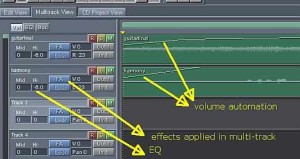If you are editing audio waveforms in digital domain, you will have two options. The first option is to edit the files non-destructively while the other option is to edit the files destructively. This is a beginner guide on how to do both of these techniques correctly.
Overview on Non-Destructive Editing of audio files
You may not aware at first but applying effects on multi-track space is a non-destructive editing process. Take a look at Adobe audition multi-track space:
You can apply important audio editing techniques such as volume change, panning, EQ and all other effects on the multi-track view without altering the original recording.
The obvious benefits are as follows:
1.) You preserve the original recording. If you make a mistake on applying effects, you simply change the settings DIRECTLY on the multi-track without the need to re-edit the audio wave files manually.
2.) This is a faster approach to editing. On the above screenshot, the multi-track editing techniques are powerful because they have automation tools. For example, volume automation, panning automation; which at a single glimpse can be used by engineers to quickly apply desired effects on the audio.
3.) You have documented evidence of your changes that results to that sound. For example, in the above screenshot, it is shown that you are applying a low pass filter at 15,000Hz -6dB. It is clearly shown on the 3 band parametric EQ. And you know the sound of this setting.
This would make it easy for you to assess and apply more accurate settings to further improve the audio quality especially during mixing.
Disadvantages of non-destructive editing:
1.) If you strictly implement non-destructive editing in all of your projects. Then you cannot solve 100% of all audio quality issues such as noise removal.
2.) Putting too many effects on the multi-track would add too much strain on your PC computing power. Then your computer would run very slow and laggy. This can easily be solved by locking the tracks (if supported by your DAW) or using a very fast computer (can be costly if you are on a very tight budget).
Great improvements on computer speed and power can be realized by using a high CPU clock speed, high amounts of RAM and modern chipsets/motherboard with optimized OS.
